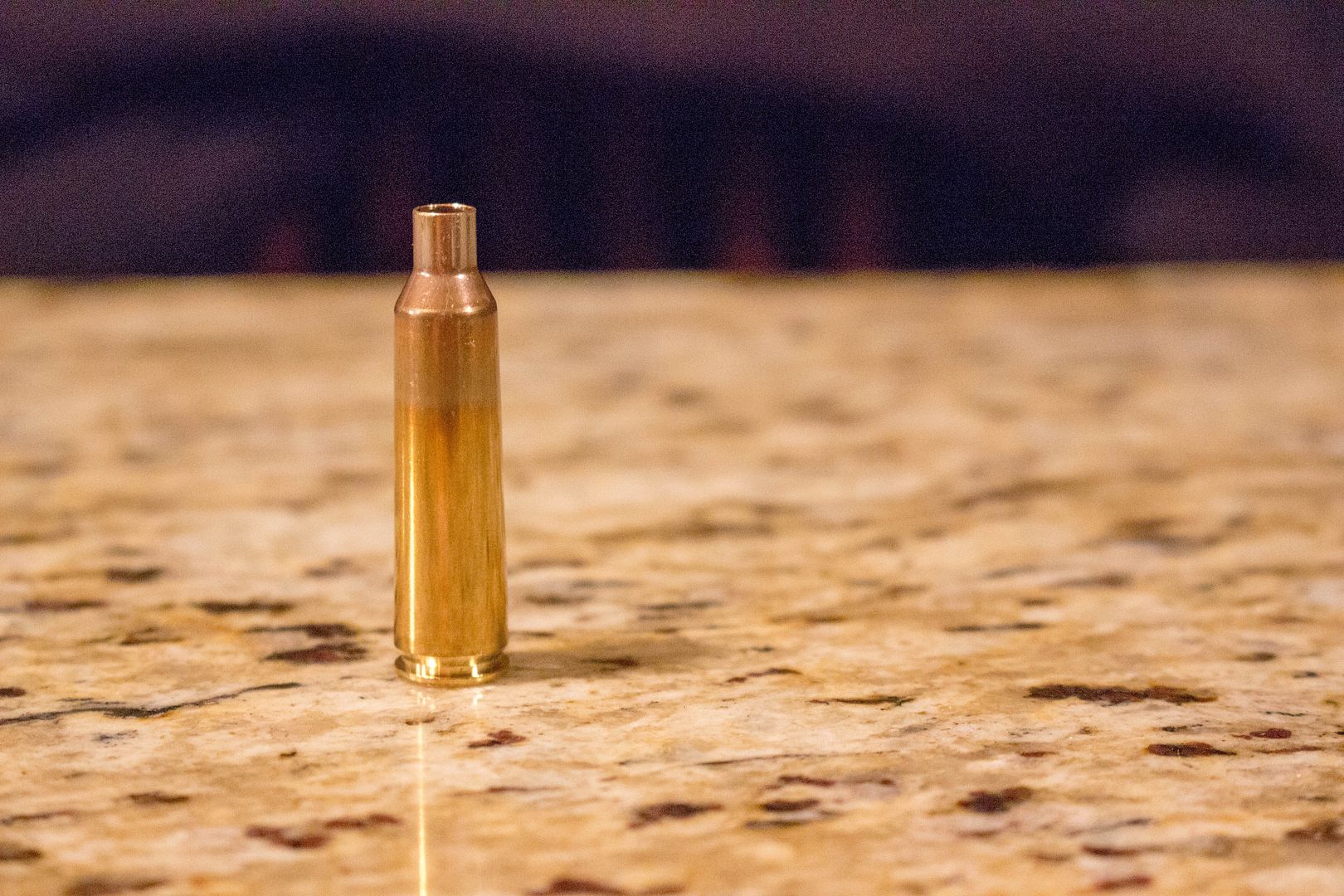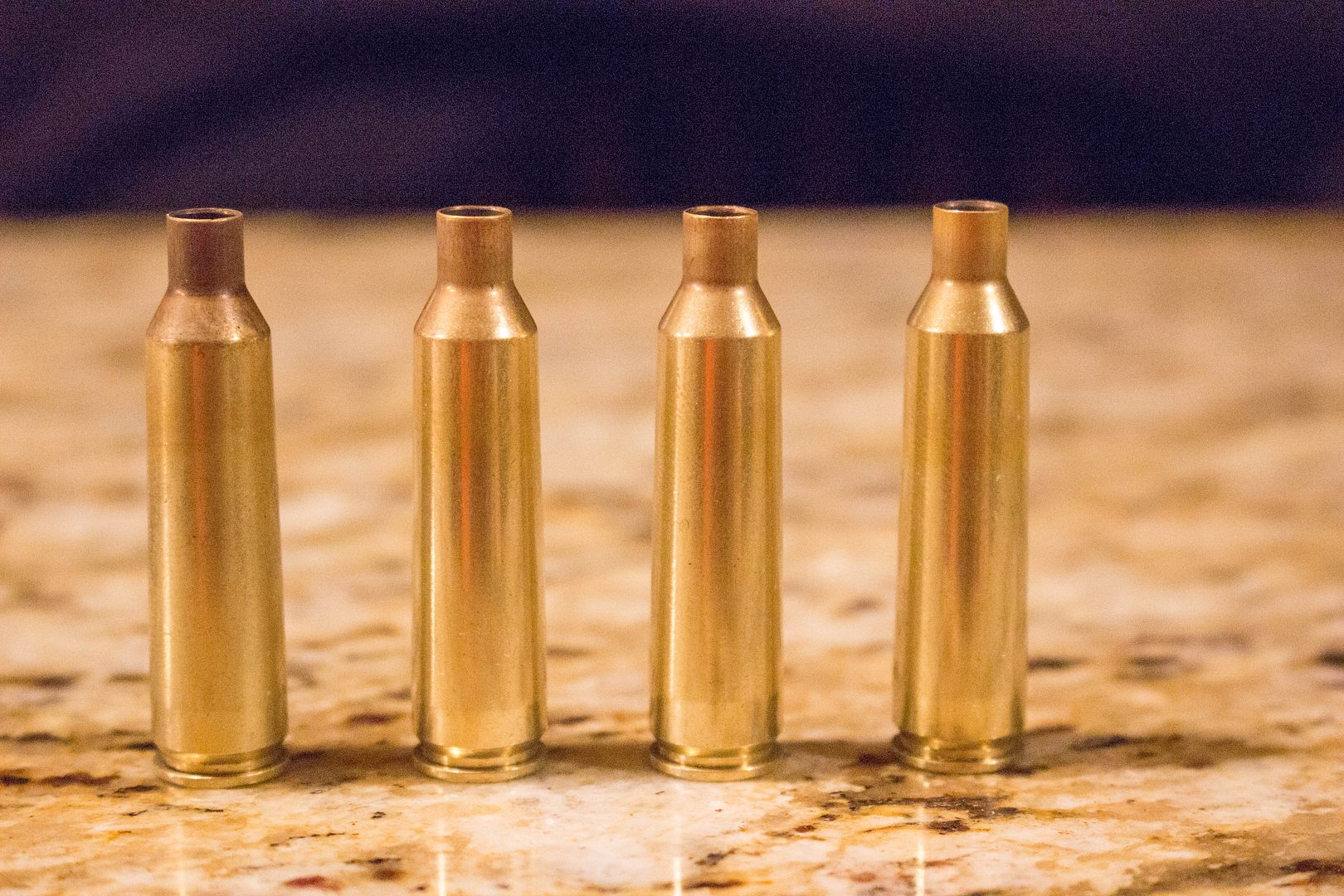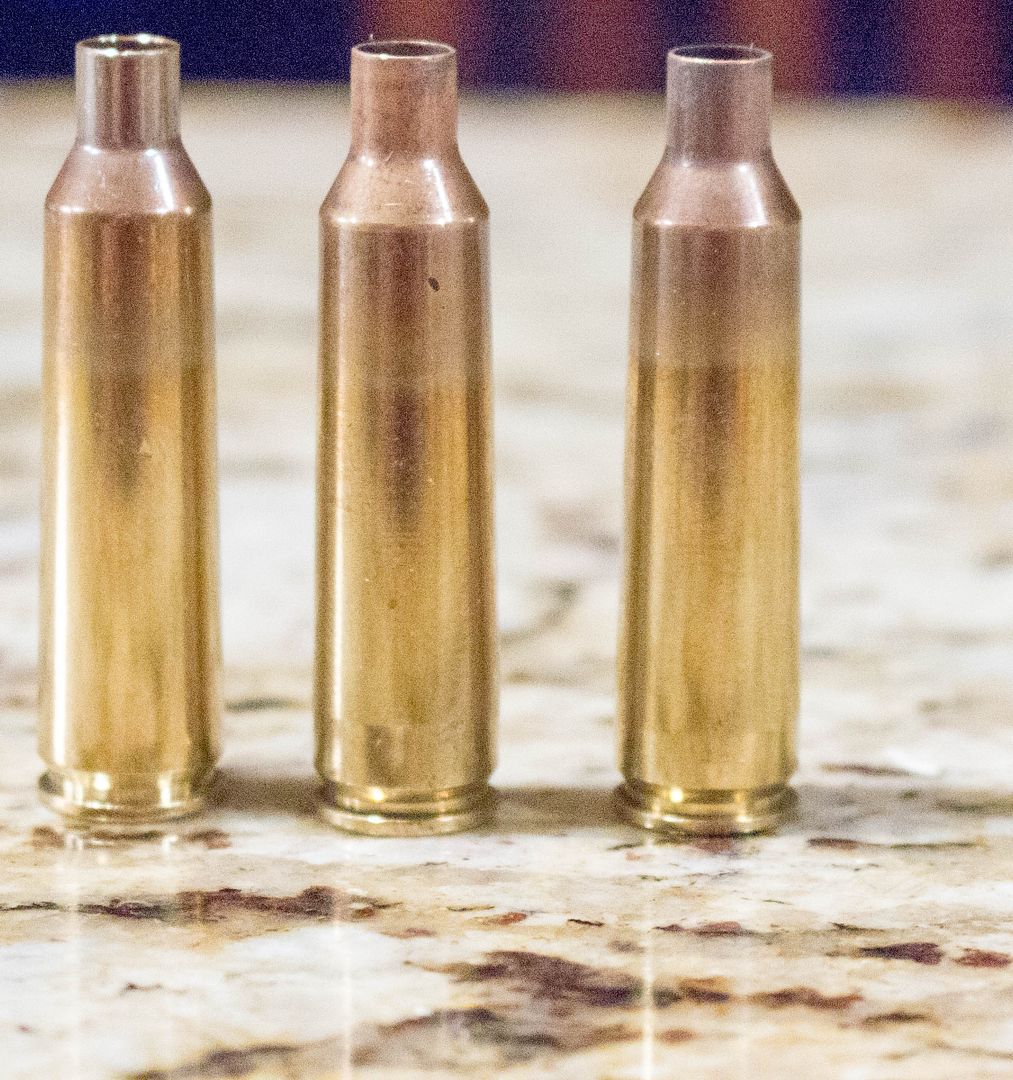

 The Accurate Reloading Forums
The Accurate Reloading Forums  THE ACCURATE RELOADING.COM FORUMS
THE ACCURATE RELOADING.COM FORUMS  Guns, Politics, Gunsmithing & Reloading
Guns, Politics, Gunsmithing & Reloading  Reloading
Reloading  Annealing
AnnealingGo  | New  | Find  | Notify  | Tools  | Reply  |  |
| One of Us |
Ok, I know there is a plethora of information online regarding annealing, which is the problem. I have spent a lot of time researching and everyone seems to have an opinion on the proper way to anneal brass. Many of these methods directly contradict one another and I do not have the experience or knowledge to tell who is correct and who is not. Best I can tell is it is critical not to over anneal the brass, which means not getting it red in the flame. I made my first attempt at annealing some 5x fired WIN 22-250 brass this evening. I chucked up the brass in a drill so I could spin it in a flame. I did a few test pieces (which I threw away) to see how many seconds it took to get it red hot in the flame. I figured out that at about the 11 second mark it would begin to turn red. 10 seconds seemed to be the spot just before turning red so that is what I went with. When I compare my brass against a test piece, factory new Lapua brass, mine does not contain the same color change. Is this something I need to worry about? For reference the first picture below is the factory new Lapua brass and the 2nd picture are 4 sample pieces from my annealing tonight. I do not know how to make heads or tails regarding the proper way to anneal. Hoping you all can help.   | ||
|
| One of Us |
Who said not to get it red? You are not getting it hot enough. I always make it red. I also rarely anneal brass unless forming it or I start getting neck splits. | |||
|
| One of Us |
Technically speaking, you aren't "annealing" brass if you don't get it to the point where it starts to glow red. Lesser temperatures are "heat treating" the brass. | |||
|
| one of us |
From my old Norma booklet : "Norma Gunbugs Guide ", 1967 [they ought to know something ! ] "Stand them in a pan of water ,to about 3/4 of their height.With a torch heat the necks to cherry red.Immediately tip the case into the water to cool". Very simple isn't it ? Or in the words of Admiral Rickover " Is that too quick an answer for you ? " | |||
|
| One of Us |
Thank you for the replies. As I mentioned in the OP, there are many contradictory methods online. I am forced to pick the people that "seem" to know what they are doing, which is what I did in the videos I will post below, both of which state not to get the brass red. I am esecially inclined to listen to something that is published in a reloading manaual, so thank you for that mete. Those of you that get the brass glowing, how long do you want to keep it glowing? Here are two videos which both state not to get the brass red. https://youtu.be/fiIrLvAUh6o https://youtu.be/kgD5D0Wzu-c | |||
|
| One of Us |
I turn off most of the lights in my shop and I use my eyes to watch the color change and I do not use the time method As soon as I notice a slight red I dump out the brass I have always just dumped my brass into a cardboard box and not water Some replies on water vs air would be appreciated ________________________________________________ Maker of The Frankenstud Sling Keeper Proudly made in the USA Acepting all forms of payment | |||
|
| One of Us |
As soon as all the neck is uniformly red, I quench it. I always use water as it cools the brass; not sure that is actually needed; brass is not like steel, but I like the sound it makes. Oh, those videos that say not to get the brass red? That is a new theory, (a wrong one) on me. The internet is full of experts. Except here on AR. | |||
|
| one of us |
Yep red. I do it in a dark room. As soon as I get a uniform red I drop it in water. I simply use water to stop the heat transfer to the rest of the case. Is it right??? All I can say is I've done it that way for 40+ years. If there is something better I'm always willing to learn something new. As usual just my $.02 Paul K | |||
|
| one of us |
Yes Ramrod , keep the casehead cool !Softening the case head gives you a dangerous case. For those who don't know I,m a ret'd metallurgist. | |||
|
| One of Us |
In over 40 years and hundreds of thousands of rounds, I have never annealed any of my rifle cases. But there again, I have never had a case neck split on a rifle case, only on pistol cases. just my .02 | |||
|
| one of us |
Me either. I occasionally have a split neck, about the same time the primers start falling out! A shot not taken is always a miss | |||
|
| one of us |
Some of my basic rifle brass I don't fool with either. However the majority of my cases are wildcats. So taking a 280 case to 416 takes a touch of work. As usual just my $.02 Paul K | |||
|
| One of Us |
I use the same method as listed in the post from Norma. When changing caliber from a parent case, I have found that annealing is most likely to allow for change without damaging the case. Doug | |||
|
| One of Us |
Yeah, of course Ram is right, as usual. I knew there was a reason I water quenched them; to STOP the heat flow down into the head, which, as mete points out, is a no no. a huge one. | |||
|
| one of us |
| |||
|
| one of us |
I have the Hornady annealing kit. It contains a product called Tempilaq which melts at 475 F. You put some Tempilaq on the case 1/4 inch below the case shoulder. Spin the case while heating the neck with the torch. When the Tempilaq melts, you drop the case in water. I usually time the first case and just use that time for the rest of the cases rather than applying Tempilaq to all of them. | |||
|
| One of Us |
I want to thank everyone who took the time to reply to my question. I took the advice that was given to me, which countered most of what is available online and on YouTube today, and annealed a couple more cases letting them turn red. I turned off all of the lights in my garage and put 2 of the 3 cases below into the flame until they turned red uniformly around the case neck. What came out matched exactly to what is seen on the factory new Lapua case, which is also pictured below. I cannot tell a difference, can you  | |||
|
| Powered by Social Strata |
| Please Wait. Your request is being processed... |
|

Visit our on-line store for AR Memorabilia

